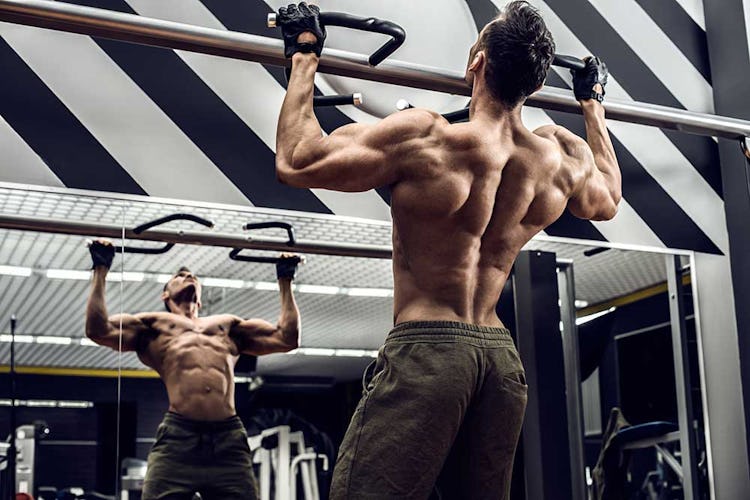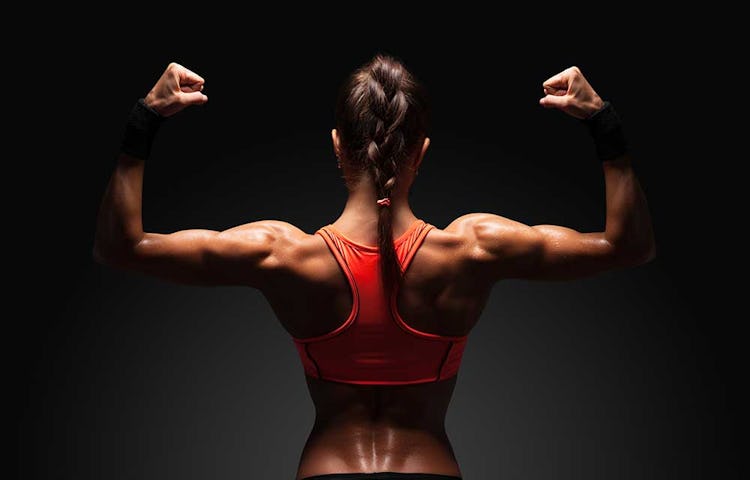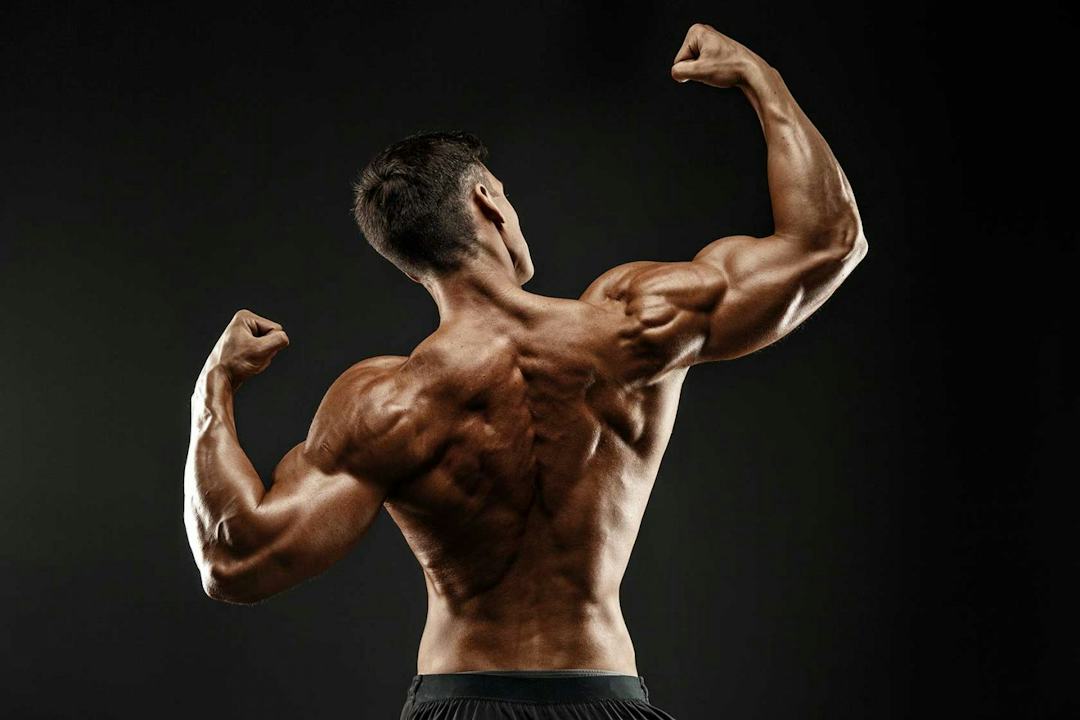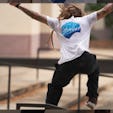If Monday is “International Chest Day” in gyms everywhere, then Tuesday might be “International Back-and-Biceps Day,” given how common it is to see those muscles paired up in a workout. (Following the cliché, leg training would unfortunately get pushed to Wednesday, at the earliest, but we’ll save that rant for another article.)

5 Killer Back and Bicep Workouts For Building Muscle
There’s no hard and fast rule stating that back and biceps need to be trained together, but, anecdotal bro science aside, there is some logic to combining these two muscle groups that allow you to pull real hard.
Our guide to training the back and biceps together will teach you how to create maximally efficient upper-body workouts that build a thick back and bulging arms.
Why Work Your Back and Biceps Together?
“When you think about back training, the secondary or tertiary mover in any sort of row, pulldown, or pullup is going to be the biceps,” says John Rusin, P.T., D.P.T., C.S.C.S., owner of DrJohnRusin.com. So, for the sake of efficiency, “it makes sense to hit the biceps a little more directly in conjunction with their corresponding compound lifts,” (i.e. back movements that involve more than one joint; as opposed to biceps exercises where only the elbow flexes).
Generally, back and bicep workouts begin with rowing or pulldown exercises to hit the bigger back muscles when you’re fresh. Starting the workout with biceps curls would fatigue your arms to the point where they may not be able to assist you like they should on your back movements, so the logical approach is to save bicep exercises until after you’ve trained your back.
One of the most popular and time-honored workout splits in all of muscledom is the push-pull split, where you train muscles that push one day and those that pull the next. For instance, you could do chest, shoulders, triceps, quads, and calves on Monday, and then work back, biceps, glutes, hamstrings, and rear deltoids on Tuesday. This kind of schedule makes it easy to keep all your training in balance, and ensures that you don’t neglect any muscle groups.
Of course, you don’t have to train your whole body each day. You could do upper-body pushing one day and upper-body pulling—aka back and biceps—the next, and then a leg day later in the week. A back and biceps session fits easily into all variations of the push-pull split.
Back and Biceps Anatomy

The major muscles involved when training back and biceps include:
Back*
–Latissimus dorsi (aka, the “lats”). These are the big sheets of muscle that extend down the sides of your back and let you pull your arms downward and backward.
–Teres major. A small muscle below the shoulder that assists with drawing your arms down and back.
–Rhomboids. Upper back muscles that elevate, retract, and rotate the shoulder blades downward.
–Middle and lower trapezius (“traps”). These guys retract and depress the shoulder blades.
Biceps
– Biceps brachii: Your main biceps muscle, it twists (supinates) the wrist outward and flexes the elbow.
– Brachialis: This one lies between your biceps and triceps on the outer side of your arm. It flexes the elbow.
*When discussing “back training” in strength and conditioning circles, experts are usually referring to the upper back. The lower back—meaning the erector spinae muscles—are considered part of the core musculature, and are also involved heavily in leg exercises, such as deadlift and squat variations. You can certainly include lower-back exercises in your back and biceps workouts if you choose to, but be sure to factor in the stress that your other workouts may be putting on the area, and be careful not to overwork it.
The Best Back And Bicep Exercises
Back and biceps exercises can be broken up into different categories. There are three types of back exercises, and five types of biceps exercises.
Back
1. Horizontal pulls (rows). To understand how the back exercise categories work, picture your body in a standing position. If you pull something toward your midsection, you’re moving it along a horizontal plane. Any exercise done along that plane is a type of row—be it a seated cable row, face pull, one-arm dumbbell row, etc. Even when you change the position of your torso, such as by bending your hips back to angle it so your torso is parallel to the floor (as in a bent-over barbell row), you’re still pulling toward your body as if it were erect, and the exercise is still classified as a horizontal pull.
“Rows should make up the majority of your training volume for back,” says Rusin. “When rowing with dumbbells or handles, you can rotate the hands to achieve a more externally rotated position at the top of the pull [thumbs pointing away from you]. You can’t do that with pulldowns and pullups; with those, the shoulder has to internally rotate, and we’re already doing enough of that in everyday life through driving, texting, and typing. Our training should be trying to get us out of that, which is why I prescribe a ton more volume on horizontal pulls versus vertical.”
Target muscles: Rows effectively train all the major back muscles—lats, teres major, rhomboids, and trapezius. Developing the latter two in particular makes for a thicker, meatier back.
Exercise variations: Barbell bent-over row, one-arm dumbbell row, bodyweight row (with a suspension trainer or a barbell set up in a power rack or Smith machine), seated cable low row, T-bar row, landmine row, Meadows row, trap-bar row, chest-supported row, machine row (plate-loaded, selectorized, Smith machine), Pendlay row.
2. Vertical pulls (pullups/chinups, lat pulldowns)
Vertical pulling is a little simpler to picture than horizontal pulling. Movements that have you pull yourself upward in a straight line, or pull a bar down to meet you, are known as vertical pull exercises, and include the many pullup and lat pulldown variations.
Target muscles: Lat pulldowns and pullups emphasize the upper lats and teres major, adding width to the upper back.
Exercise variations: Wide-grip lat pulldown, neutral-grip lat pulldown, reverse-grip lat pulldown, wide-grip pullup, neutral-grip pullup, chinup, assisted pullup or chinup (using a machine or bands).
3. Isolation exercises (straight-arm pulldowns and pullovers).
While horizontal and vertical pulls are always compound lifts and involve the biceps as a secondary mover, exercises like the straight-arm pulldown and pullover, on the other hand, virtually remove biceps muscle involvement by keeping the elbows in a fixed position throughout. This allows you to zero in on the lats and various upper back muscles more directly, forcing them to do the work unassisted. “You’ll need to use lighter weight with these exercises,” says Rusin, “but the mind-muscle connection tends to be higher with these isolation movements.” That is, your ability to focus your mind on the muscles you want to train will be easier, and that improves their potential to grow.
Target muscles: Straight-arm pulldowns and pullovers emphasize the lats and teres major, with very little involvement from the biceps.
Exercise variations: Straight-arm pulldown (rope or bar attachment), one-arm straight-arm pulldown, dumbbell pullover, barbell pullover, cable pullover, dumbbell pullback.

Biceps
Because the elbow is a simple hinge joint, there’s really only one movement you can do for direct biceps training: the curl. However, curls can be manipulated through both hand and shoulder position to target the biceps (and their surrounding assisting muscles) very differently. Hence, there are five types of curls.
1. Supinated-grip curls (standard curls). In a typical barbell, dumbbell, or machine curl, the forearms are in a supinated position, with the palms facing forward at the bottom.
Target muscles: Supinated curls place the brunt of the load on the biceps brachii (the main arm muscles when you flex your elbow).
Exercise variations: Barbell curl, dumbbell curl (standing or seated), cable curl (bar attachment).
2. Neutral-grip curls (hammer curls). When you turn your wrists so that your palms face in toward your body, you’re doing a hammer curl (or some variation).
Target muscles: The brachialis muscle, which lies beneath the biceps brachii, becomes more involved in the movement, as does the brachioradialis, the meaty muscle that runs along the thumb-side of your upper forearm. However, the biceps are still the prime mover.
Exercise variations: Dumbbell hammer curl, cable hammer curl (rope attachment), neutral-bar hammer curl, cross-body hammer curl.
3. Pronated-grip curls (reverse curls). The opposite of a supinated grip, pronated curls flip your grip so that the palms face toward you in the down position and downward to the floor at the top of the lift.
Target muscles: Pronated/reverse curls hit the brachialis and brachioradialis to a greater extent than both supinated and neutral-grip curls.
Exercise variations: barbell reverse curl, dumbbell reverse curl, cable reverse curl, preacher reverse curl (dumbbell, barbell, or cable version).
4. Shoulder flexion (preacher curls). When doing curls using a preacher bench, the upper arms are locked into a position of slight shoulder flexion. Your elbows are held in front of your body.
Target muscles: The flexed shoulder position helps you better isolate the biceps, and helps establish a stronger mind-muscle connection (probably because you can watch your biceps as you train them!).
Exercise variations: Barbell/EZ-bar preacher curl, dumbbell preacher curl, machine preacher curl, cable preacher curl.
5. Shoulder extension (incline curls). In contrast to the preacher curl, you can get a greater stretch on the biceps by keeping the upper arms behind the torso (shoulder extension) throughout the curling movement. The most common way to do this is by lying back on an incline bench so that the upper arms are perpendicular to the floor throughout the movement.
Target muscles: Performing a curl while the biceps are in a stretched position puts slightly more emphasis on the long head of the biceps, the outermost portion of the muscle that provides most of the muscle’s peak when you flex it.
Exercise variations: Incline dumbbell curl, incline cable curl, standing one-arm behind-the-back cable curl.

How Many Back Exercises And Biceps Exercises Should I Do?
Although the back and biceps work together on virtually all compound upper-body pulling movements, the amount of work the two muscle groups can tolerate is vastly different. Rusin recommends anywhere from four to six exercises total for back and biceps in a given workout, using roughly a two-to-one ratio of back to biceps exercises. At the high end, this would mean four back exercises and two isolated biceps movements in a session.
“The back can be trained multiple days a week,” says Rusin. Since its muscles support your posture all day long, they’re very durable, and can recover from quite a workload. “But the biceps can’t take the same amount of training volume and frequency as the back. People often think about doing back and biceps workouts with a one-to-one ratio of exercises—doing one biceps exercise for every back exercise—but that doesn’t line up for long-term success in terms of health and results.”
Yes, the biceps are relatively small muscles, and smaller ones generally recover faster than big muscles. But the biceps act on the elbows and shoulders—two joint complexes you really don’t want to risk overworking, especially when you’re already training chest, triceps, and shoulders elsewhere in your week.
According to Rusin, “Most people simply can’t tolerate more than one day a week of dedicated biceps training in terms of shoulder and elbow health and recoverability—even the bodybuilders I work with.”
How Many Sets and Reps Should I Do for Back and Biceps?
A good rule of thumb, especially if you’re on the high end of the exercise count, is 2 to 3 working sets per exercise. A working set means not a warmup—you’re using a challenging load and going to failure, or close to it (within one or two reps of failure).
In many cases, you won’t hit the aforementioned two-to-one ratio of back to biceps exercises perfectly; for example, you may do 3 back exercises and 2 for biceps. In these instances, aim for a two-to-one ratio of total sets (in this example, 6 total sets for back and 3 for biceps).
Rusin prescribes 8 to 25 reps for back exercises (with 45–75 seconds rest between sets). For biceps, you can do 10 reps all the way up to 50 (20–45 seconds rest between them).
Rusin says you can tweak your back training to emphasize strength or maximum muscle growth (low reps for strength; moderate to extremely high reps for growth), but with biceps, there’s no need to train for strength. The elbows aren’t designed to curl ever-increasing loads, so you’ll get more out of them (and keep them healthy) by training them for hypertrophy (max muscle gain) via going for a big pump. “That’s what the biceps respond best to,” says Rusin.

How Should I Set Up A Back and Biceps Workout?
Just as important as the exercises you choose for your workout is the order you do them in. Rusin follows a simple protocol that delivers results in size and strength and minimizes the risk for injury. He calls the system the three P’s: Prime, Perform, and Pump.
1) Prime. You want to start your workout with an exercise that primes the central nervous system, essentially waking up the muscles you’re trying to train so that you can best recruit them throughout the workout. This should be a lift that you can really feel the target muscles working on. It may be an isolation lift or a compound one, but it should be done with fairly light weight so you can focus on form and making a mind-muscle connection. Done right, the priming exercise will help flush blood into the muscles and reduce your risk for injury.
For the back, straight-arm pulldowns, are a good choice. You could also go with a machine or chest-supported row (something where the body is supported and the movement is somewhat isolated). For the biceps, Rusin recommends hammer curls. Reps for both primer exercises should be in the range of 12–25.
“I always do neutral-grip curls to hit the underlying brachialis before fully lengthening out the biceps with supinated curls,” says Rusin. “So, for example, I wouldn’t do preacher curls before hammers.” Training the muscles in a stretched position when they aren’t fully activated can lead to biceps muscle pulls or elbow pain.
2) Perform. Following the prime, you’ll do one or two strength-focused lifts using heavier weights and lower reps (around 8, give or take). This is the real meat-and-potatoes of your workout, but don’t think that means you can skip the prime exercise and jump right into it.
For back, barbell and dumbbell rows are money. Pullups can also be done here, simply because Rusin says most people can’t do more than 8–15 reps of them, so they can’t go in the (next) pump phase of the workout. For biceps, barbell and dumbbell curls, or cable curls will suffice.
3) Pump. Here’s where you chase total hypertrophy and finish the muscle off using light- to moderate-weight and moderate- to high-reps.
“What we don’t want is the spine, core position, or posture to be the limiting factor in any back exercise when we’re chasing those higher rep ranges,” says Rusin. This is why an exercise like the lat pulldown is perfect here; being seated and locked into place minimizes core and postural muscle involvement. Seated cable rows, machine rows, and rows with a band are also good options.
For biceps, preacher curls, incline dumbbell curl, and band curls work well. “Any curls where you’re putting a stretch on the biceps should definitely be at the back of the workout,” says Rusin.
How To Stretch Before Doing Back and Bis
Warm up for a back and biceps workout by following these mobility drills from Onnit-certified Durability Coach Cristian Plascencia (@cristian_thedurableathlete on Instagram).
The Best Back and Biceps Workouts
All of the below workouts follow the Prime-Perform-Pump (PPP) protocol for back and biceps. Select whichever one(s) accommodates your individual fitness level and/or equipment setup. The workouts are meant to provide a basic template to illustrate the PPP concept; you can insert whichever exercises you want into the template as long as you follow the PPP guidelines.
Do only one back-and-biceps workout per week. However, advanced trainees should be able to handle additional back training during the week.
Beginner Back and Biceps Workout (Option A)
[See the video above at 00:58]
1. Straight-Arm Pulldown (Prime)
Sets: 3 Reps: 15–20
[See the video at 1:00]
See our complete guide to this movement HERE.
2. One-Arm Dumbbell Row (Perform)
Sets: 3 Reps: 8–10 (each side)
[See the video at 1:38]
Grasp a dumbbell in one hand and rest your opposite hand and knee on a bench for support. Keep a long spine from your head to your pelvis and square your shoulders to the floor.
Row the dumbbell to your hip, drawing your shoulder back and downward as you pull. Your elbow should not rise higher than your back. Lower your arm under control. Complete your reps on one side and then repeat on the other immediately.
3. Lat Pulldown (Pump)
Sets: 2 Reps: 20
[See the video at 2:08]
Sit at a pulldown station, and secure your knees under the pads. Grasp the bar with your hands outside shoulder width and your palms facing away. Drive your shoulder blades down and together as you pull the bar to your collarbone, and control its path back up.
4. Dumbbell Hammer Curl (Prime/Pump)
Sets: 3 Reps: 12–15 (each side)
[See the video at 2:27]
Stand holding a dumbbell in each hand by your side, palms facing in. Without moving your upper arms, curl the weights up until your biceps are fully contracted.
5. Preacher Curl (Pump)
Sets: 1 Reps: 25–30
[See the video at 2:45]
Sit at a preacher bench or use a preacher machine. You can do the exercise with both arms, or one arm at a time, as shown. Rest your triceps on the pad so that your elbows are near the bottom of the pad and curl the weight strictly. As you extend your elbows, stop short of straightening your arms completely.
Beginner Back and Biceps Workout (Option B)
[See the video at 03:07]
1. Lat Pulldown (Prime)
Sets: 3 Reps: 15–20 (submaximal weight)
[See the video at 3:10]
See the directions above. Use a weight that allows you to perform all the reps and a few more, but do only the prescribed number.
2. Suspension-Trainer Bodyweight Row (Perform)
Sets: 3 Reps: 8
[See the video at 3:30]
Grasp the handles of a suspension trainer with palms down and hang suspended with your legs extended in front of you. Brace your core and pull your body up until your back is fully contracted. Rotate your wrists so that your palms face up in the top position. To make the exercise easier, increase the height of the handles so your body is more vertical. To make it harder, lower the handles so you’re closer to parallel to the floor.
3. Machine Low Row (Pump)
Sets: 3 Reps: 25
[See the video at 4:01]
Attach a V-grip handle, or two individual grip handles, to the pulley of a seated cable row station. Keeping your lower back flat, reach forward and grasp the handle, allowing your shoulder blades to be stretched. Row the handle to your sternum, squeezing your shoulder blades together and downward. Lower the weight with control.
4. Cable Hammer Curl (Prime/Pump)
Sets: 3 Reps: 20
[See the video at 4:18]
Attach a rope handle to the low pulley of a cable station and grasp an end in each hand. Step back so there is tension on the cable and bend your knees slightly. Keeping your upper arms in line with your sides, curl the rope until your biceps are fully contracted, pausing for a moment at the top.
5. Dumbbell Curl (Pump)
Sets: 2 Reps: 30
[See the video at 4:40]
Stand with feet hip-width apart, holding dumbbells at your sides with palms facing forward. Keeping your upper arms at your sides, curl the weights up and hold at the top for a moment.
Advanced Back and Biceps Workout (Option A)
[See the video at 04:57]
1. Band Row (Prime)
Sets: 3 Reps: 20
[See the video at 4:58]
Attach a band to a sturdy object and grasp the other end with both hands, palms facing each other. Step back to put tension on the band, and get into an athletic stance with hips and knees bent. Row the band to your sternum and hold for a moment.
2. Bentover Row (Perform)
Sets: 3 Reps: 8–10
[See the video at 5:24]
Place a barbell on a rack set to hip level. Grasp the bar with hands shoulder width, and pull the bar out of the rack. (If you’re more experienced, and have a strong lower back, you can also deadlift the bar off the floor to start.) Step back, and set your feet hip-width apart, holding the bar at arm’s length against your thighs.
Take a deep breath, and bend your hips back—keeping your head, spine, and pelvis aligned. Bend until your torso is nearly parallel to the floor. Draw your shoulder blades back and down as you pull the bar up to your belly button.
3. Chinup (Perform)
Sets: 3 Reps: 8
[See the video at 5:54]
Hang from a chinup bar with hands shoulder-width apart and palms facing you. Draw your shoulder blades down and together as you pull yourself up until your chin is over the bar. If that’s too easy, add weight with a belt as shown.
4. Lat Pulldown (Pump)
Sets: 3 Reps: 25
[See the video at 6:11]
See the directions above.
5. Dumbbell Hammer Curl (Prime/Pump)
Sets: 3 Reps: 15–20
[See the video at 6:30]
See the directions above.
6. Barbell Curl (Pump) OR Dumbbell Curl
Sets: 3 Reps: 25–30
Stand with feet hip-width apart holding a barbell at arm’s length with palms facing up. Keeping your upper arms at your sides, curl the bar until your biceps are fully contracted.
[See the video at 6:46 for a demonstration of the dumbbell curl.]
Advanced Back and Biceps Workout (Option B)
[See the video at 07:05]
1. Band Straight-Arm Pulldown (Prime)
Sets: 3 Reps: 15–20
[See the video at 7:07]
See our complete guide to this movement HERE.
2. Pullup (Perform)
Sets: 3 Reps: 8
[See the video at 7:53]
Perform as you did the chinup, described above, but with hands outside shoulder width and palms facing away from you.
3. Meadows Row (Perform)
Sets: 3 Reps: 10
[See the video at 8:09]
Set up a barbell in a landmine unit, or wedge one end into a corner. Stand perpendicular to the bar and stagger your stance, bending down to reach the bar with your lower back flat—head, spine, and pelvis should be aligned. Grasp the bar overhand and row it to your side. You should feel a stretch in your lat in the down position.
4. Lat Pulldown (Pump)
Sets: 3 Reps: 25
[See the video at 8:37]
See the directions above.
5. Cable Hammer Curl (Prime/Pump)
Sets: 3 Reps: 20
[See the video at 8:57]
See the directions above.
6. Preacher Curl (Pump)
Sets: 3 Reps: 40–50
[See the video at 9:20]
See the directions above.
At-Home Back and Biceps Workout
[See the video at 09:41]
1. Band Straight-Arm Pulldown (Prime)
Sets: 3 Reps: 20
[See the video at 9:42]
See our complete guide to this movement HERE.
2. Suspension-Trainer Bodyweight Row (Perform)
Sets: 3 Reps: 8–10
[See the video at 10:36]
See the directions above.
3. Band Row (Pump)
Sets: 3 Reps: 25
[See the video at 11:06]
See the directions above.
4. Band Hammer Curl (Prime/Pump)
Sets: 2 Reps: 30
[See the video at 11:23]
Perform hammer curls as described above, but holding an elastic exercise band.
5. Suspension Trainer Curl (Pump)
Sets: 2 Reps: 20–30
[See the video at 11:43]
Set up as you would to do the suspended bodyweight row described above, but curl the handles to your shoulders. Keep your shoulder blades drawn back together and downward throughout the exercise. Brace your core as well.

)




